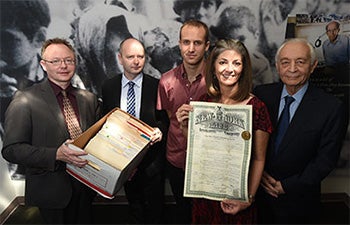A Century of Voices
To commemorate the 100th anniversary of the Armenian Genocide in April, USC Shoah Foundation — The Institute for Visual History and Education will debut a month-long series of testimony clips from survivors and witnesses of the 20th century’s first genocide.
One clip a day is being released on the institute’s website through the last day of April, which is Genocide Awareness and Prevention Month. Included on the month-long timeline will be the April 24 anniversary of the Armenian Genocide’s onset.
The clips will showcase some of the more than 400 testimonies from the Armenian Genocide that will be integrated into the institute’s Visual History Archive, which contains 53,000 testimonies from survivors and witnesses of the Holocaust and other genocides.
To help put the clips into perspective, experts steeped in knowledge about the Armenian Genocide will introduce each one. The presenters will also recommend additional resources for those who would like to learn more.
Richard Hovannisian, one of the world’s leading scholars on the Armenian Genocide and adjunct professor of history at USC Dornsife, will introduce the first five clips.
“This project will help preserve evidence of a genocide that must be acknowledged,” said USC Shoah Foundation Executive Director Stephen D. Smith. “It will honor the memory of those whose lives were taken, and it will ensure that future generations are able to learn from individuals who experienced the Armenian Genocide firsthand.”

From left, Wolf Gruner, Stephen Smith, Evan Backer, Andrea Marootian and Vartkes Yeghiayan at the USC Shoah Foundation for the donation of Yeghiayan’s New York Life lawsuit documents. Photo courtesy of AFP.
In addition to the web series, USC Shoah Foundation will also commemorate the 100th anniversary through the following events:
- The institute’s Center for Advanced Genocide Research will take possession of its first major donation since it was announced in April 2014 by USC Shoah Foundation founder Steven Spielberg and USC President C. L. Max Nikias. The donation from attorney Vartkes Yeghiayan pertains to the historic agreement reached with New York Life in 2004 that resolved more than 2,000 insurance claims against policies issued by New York Life to Armenians in the Turkish Ottoman Empire before 1915. The 40-plus boxes of materials mark the first major acquisition by the center, which is seeking private papers, documents, photographs and films pertaining to genocides to expand the university’s position of being the only world-renowned private research institution with substantial original primary-source material from genocides.
- On April 8, the Center for Advanced Genocide Research will hold a lecture with Ugur Ümit Üngör, associate professor of history at Utrecht University and research fellow at the Institute for War, Holocaust, and Genocide Studies in Amsterdam. His topic will be “The Kurds and the Armenian Genocide: Collaboration and Resistance.” Presented in cooperation with USC Institute of Armenian Studies and DEFY: USC Shoah Foundation Student Association, the lecture will be at 4 p.m. in the Tutor Campus Center, Room 450 — The Forum.
- On April 10, Hayk Demoyan, director of the Armenian Genocide Museum-Institute in Yerevan, Armenia, will visit the institute to sign a memorandum of understanding between the two organizations that will bring the Visual History Archive to the museum, as well as develop research programs that increase awareness and deepen knowledge and understanding of the Armenian Genocide and its consequences. This includes exploration of future opportunities to design, support or organize academic programs to advance international research on the Armenian Genocide.
- On April 24, a contingent from USC Shoah Foundation — including Hovannisian, Smith and Wolf Gruner, director of the Center for Advanced Genocide Research — will travel to Yerevan, Armenia, to participate in official commemoration ceremonies, and to further work on bringing the Visual History Archive to that country.
- On April 26, Smith will join thousands of Armenians commemorating the 100th anniversary with a special observance at the annual Armenian Genocide Commemoration in Times Square New York.

J. Michael Hagopian, who collected the testimony from Armenian Genocide survivors. Photo courtesy of USC Shoah Foundation.
The 400 Armenian testimonies being integrated into the Visual History Archive were filmed by J. Michael Hagopian and the Armenian Film Foundation between 1972 and 2004 when most of the survivors were in their 70s and 80s. Testimonies in the collection, the largest archive on film of Armenian Genocide interviews in the world, were recorded in 10 countries and 10 languages, including English, Armenian, Arabic, Kurdish and Turkish.
“Thanks to the foresight of Dr. Hagopian, the stories of the Armenian Genocide cannot be denied,” said Dr. Carla Garapedian, who is leading the Armenian Film Foundation’s work to preserve and integrate the collection into the Visual History Archive. “These survivors all have important stories to share, and now they will reach a far wider audience.”
The Armenian testimonies were first delivered to the institute in April 2014 to begin the integration process into the Visual History Archive, which included indexing all the testimonies. At the core of USC Shoah Foundation’s indexing system is a one-of-a-kind thesaurus, which includes over 62,000 terms that describe genocide-related concepts and experiences that cover the Holocaust, Rwandan Genocide and Nanjing Massacre, all experiences reflected in the Visual History Archive. Indexing allows students, teachers, professors and researchers to search the Visual History Archive by specific terms.
Hagopian was an Emmy-nominated filmmaker who made 70 educational documentaries. Seventeen of his movies centered on Armenian culture and history, including an epic trilogy on the Armenian Genocide composed of “Voices from the Lake,” “Germany and the Secret Genocide” and “The River Ran Red.” He was a survivor of the genocide that killed an estimated 1.5 million people in Turkey from 1915–23. In 1979, he founded the Armenian Film Foundation, a Thousand Oaks, California-based nonprofit dedicated to documenting Armenian heritage. Hagopian died in December 2010 at age 97.